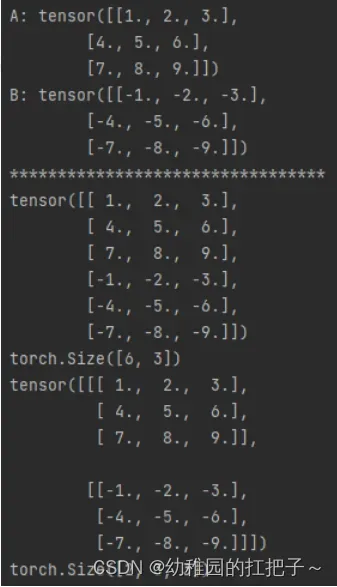关于torch.cat()与torch.stack()整理
代码中一直使用torch.cat()和torch.stack()进行tensor维度拼接,花点时间整理下。方便使用🤷♂️:
1.用法
torch.cat(): 用于连接两个相同大小的张量
torch.stack(): 用于连接两个相同大小的张量,并扩展维度
见代码示例更清晰:
import torch
a = torch.tensor(torch.arange(10)).reshape(3, 3)
b = torch.tensor(torch.arange(10, 100, 10)).reshape(3, 3)
print(a)
Out[7]:
tensor([[1, 2, 3],
[4, 5, 6],
[7, 8, 9]])
print(b)
Out[10]:
tensor([[10, 20, 30],
[40, 50, 60],
[70, 80, 90]])
对上面两个tensor进行操作
torch.cat()
拼接函数,将多个张量拼接成一个张量,保持维度不变。torch.cat()有两个参数,第一个是要拼接的张量的列表或是元组;第二个参数是拼接的维度。
使用不同的参数,输出的结果不同,首先填入一个会返回错误的参数:从返回报错原因可以看到,参数的返回必须是在[-2, 1]之间。
d3 = torch.cat((a, b), dim=2)
# 返回输出如下
Traceback (most recent call last):
File "/home/franklinpan/.local/lib/python3.8/site-packages/IPython/core/interactiveshell.py", line 3251, in run_code
exec(code_obj, self.user_global_ns, self.user_ns)
File "<ipython-input-23-b2602bd6230f>", line 1, in <module>
d3 = torch.cat((a, b), dim=2)
IndexError: Dimension out of range (expected to be in range of [-2, 1], but got 2)
设置dim=-1,得到如下结果,当参数为-1时,与dim=1的返回结果相同
dim=-1,表示在第二维度进行拼接
d_1= torch.cat((a, b), dim=-1)
print(d_1)
Out[25]:
tensor([[ 1, 2, 3, 10, 20, 30],
[ 4, 5, 6, 40, 50, 60],
[ 7, 8, 9, 70, 80, 90]])
d1 = torch.cat((a, b), dim=1)
print(d1)
Out[22]:
tensor([[ 1, 2, 3, 10, 20, 30],
[ 4, 5, 6, 40, 50, 60],
[ 7, 8, 9, 70, 80, 90]])
设置dim=-2,与dim=0相同:
表示在第一维度进行拼接
d_2= torch.cat((a, b), dim=-2)
print(d_2)
Out[27]:
tensor([[ 1, 2, 3],
[ 4, 5, 6],
[ 7, 8, 9],
[10, 20, 30],
[40, 50, 60],
[70, 80, 90]])
d1 = torch.cat((a, b), dim=0)
print(d1)
Out[20]:
tensor([[ 1, 2, 3],
[ 4, 5, 6],
[ 7, 8, 9],
[10, 20, 30],
[40, 50, 60],
[70, 80, 90]])
可以看到,采用不同的参数,输出的张量维度仍然与原来张量的维度保持一致。
若输入参数的维度不一样,会产生什么结果呢?
当输出张量保持一个维度一致时,若在相同维度的方向进行连接torch.cat操作,则仍然可以张量的合并操作,若在维度不同的方向进行连接操作,会报错。(🤦♀️torch.cat操作没有广播机制)
**torch.stack()**操作
拼接函数,是拼接以后,再扩展一维。torch.stack()有两个参数,第一个是要拼接的张量的列表或是元组;第二个参数是拼接的维度。
此处不再重复dim=-3 or -2等操作,当dim=0时
c1 = torch.stack((a, b), dim=0)
Out[12]:
tensor([[[ 1, 2, 3],
[ 4, 5, 6],
[ 7, 8, 9]],
[[10, 20, 30],
[40, 50, 60],
[70, 80, 90]]])
当dim=1时
c2 = torch.stack((a, b), dim=1)
Out[15]:
tensor([[[ 1, 2, 3],
[10, 20, 30]],
[[ 4, 5, 6],
[40, 50, 60]],
[[ 7, 8, 9],
[70, 80, 90]]])
当 dim=2时
c3 = torch.stack((a, b), dim=2)
Out[17]:
tensor([[[ 1, 10],
[ 2, 20],
[ 3, 30]],
[[ 4, 40],
[ 5, 50],
[ 6, 60]],
[[ 7, 70],
[ 8, 80],
[ 9, 90]]])
若在torch.stack中使用不同维度的输入,得到报错的反馈
从实例可见,torch.stack操作将会增加合并后张量的维度。
总结:
torch.cat()与torch.stack()操作都是对张量进行拼接操作,不同点如下:
torch.stack()将对张量维度进行扩张
torch.cat()可以对只有一个方向维度相同的张量进行合并,而torch.stack()要求输入张量的维度必须一样。
stack与cat的区别在于,得到的张量的维度会比输入的张量的大小多1,并且多出的那个维度就是拼接的维度,那个维度的大小就是输入张量的个数。见下面代码:
A=torch.tensor([[1,2,3],[4,5,6],[7,8,9]],dtype=torch.float)
print("A:",A)
B=torch.tensor([[-1,-2,-3],[-4,-5,-6],[-7,-8,-9]],dtype=torch.float)
print("B:",B)
print("*********************************")
c=torch.cat((A,B),dim=0)#保持维度不变
print(c)
print(c.shape)
d=torch.stack((A,B),dim=0)#多扩展一维度
print(d)
print(d.shape)
运行结果:

扩展:
torch.cat和torch.stack()的拼接为[]数据时:
见拼接列表数据
文章出处登录后可见!
